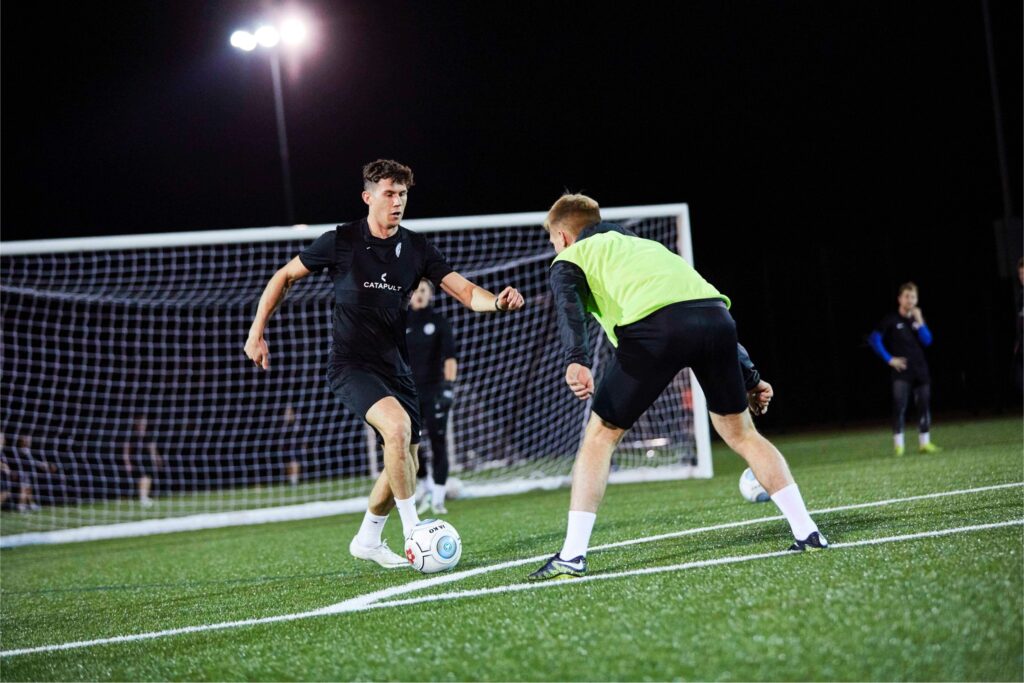Introduction: Sports Training Begins a New Age
Sport is going quicker than ever. The days of running laps and weight-lifting are gone. Today’s sportsperson trains with accuracy, with data, and with intelligent technology. From performance monitoring through AI to virtual coaching, sports training has come a long way.
Athletes, coaches, and sports scientists are now leveraging technology, analytics, and neuroscience to gain an advantage. These new techniques are more precise, tailored, and effective than ever. Ahead, the future of sports training will bring improved outcomes with less injury.
This article discusses the largest changes, technologies, and trends influencing the future of athletic development.
1. Smart Wearables and Real-Time Data
A New Age of Tracking Performance
Today’s athletes don’t trust guesswork. They are equipped with smart wearables that track:
- Heart rate
- Speed
- Distance
- Fatigue
- Sleep quality
Tools such as WHOOP, Garmin, and Catapult provide immediate feedback to coaches and athletes. These devices indicate what’s working and what’s not.
Training With Precision
With wearable data, the coach can optimize every workout according to the athlete’s state. This minimizes the risk of injury and maximizes efficiency. For instance:
If an athlete’s heart rate indicates overtraining, the coach can lower the intensity.
If sleep data shows poor recovery, training volume can be adjusted.
Future Outlook
Soon, we’ll see wearables with AI-based recommendations. Athletes won’t just see numbers — they’ll get real-time advice from smart algorithms.
2. Virtual Reality (VR) and Augmented Reality (AR)
Training the Mind and Body
Physical fitness is key, but so is decision-making. VR and AR tools help athletes improve:
- Reaction time
- Focus
- Game awareness
- Strategy execution
Football quarterbacks, for instance, can practice reading defenses in VR without the need to be on the field.
AR in Real-World Environments
AR glasses can superimpose training data as the athlete walks. For instance:
Cyclists can view speed and altitude without referencing devices.
Tennis players can receive real-time shot analysis during play.
Cost and Availability
Though these technologies were once reserved for elite squads, costs are decreasing. Soon, high school players will have access to the same tools as professionals.
3. AI and Machine Learning in Coaching
Smarter Insights Than Ever Before
AI has the ability to dissect millions of data points — quicker than any human. Through video, statistics, and biomechanics, AI delivers actionable insights.
Examples:
AI can recognize subtle changes in running form that may lead to injury.
Machine learning is able to detect performance patterns and forecast dips.
Personalized Plans
No two athletes are identical. AI facilitates customized training programs based on each athlete’s:
- Age
- Level of strength and strength level
- Sport
- Rate of recovery
- History of injury
This individualization enhances results and reduces wasted time.
4. Biomechanics and Motion Capture Technology
Training From the Inside Out
High-speed cameras and sensors now monitor:
- Muscle movement
- Joint angles
- Body alignment
- Ground reaction force
This allows trainers to gain profound understanding of the way athletes move. They are able to correct errors, enhance form, and forestall permanent damage.
Examples in Sports
Baseball pitchers receive feedback on arm angle to prevent shoulder injury.
Runners view foot strike patterns to alleviate knee stress.
Fewer Injuries, Longer Careers
By fixing small problems early, athletes remain healthier. Motion tracking doesn’t just make training smarter — but safer as well.
5. Mental Training and Neurofeedback
The Brain Is a Muscle Too
Top athletes train their brains as aggressively as their bodies. New sports psychology tools assist with:
- Focus
- Confidence
- Recovery
- Stress control
Neurofeedback Tools
Now, athletes can use headsets that track brainwaves. These track the athlete’s focus or relaxation level. Coaches then create habits to enhance mental acuity.
Virtual Coaching for the Mind
Apps such as Headspace for Sport or Calm have sessions for sports people. These assist with visualization, breathing, and mindset.
6. Recovery and Regeneration Science
Training Smarter Means Recovering Better
Old-fashioned philosophy instructed, “Train harder.” New sports science instructs, “Recover smarter.”
Recovery technology encompasses:
- Cryotherapy
- Compression clothing
- Infrared saunas
- Normatec boots
- Sleep trackers
- Data-Driven Rest
Athletes monitor:
- Sleep quality
- Heart rate variability (HRV)
- Stress markers
Coaches modify training loads based on this information. This creates quicker improvements and less injury.
The Future: Real-Time Muscle Scanning
Soon, athletes will be able to use portable ultrasound or muscle sensors to pick up soreness before they can even feel it. This prevents injuries before they occur.
7. Nutrients Tracking and Personalized Diets
Powering Performance with Precision
No workout routine is complete without the right fuel. Nutrition now merges science with customizing. Athletes track:
- Calories
- Macronutrients
- Hydration
- Vitamin levels
- DNA-Based Nutrition
Some companies now provide diet plans based on a DNA test. The plans are tailored to your body’s individual requirements, eliminating guessing.
AI Diet Coaches
Lumen or MyFitnessPal Premium apps provide meal recommendations based on exercise, recovery requirements, and sleep.
8. Remote Coaching and Digital Training Platforms
Training Anywhere, Anytime
Remote coaching went wild during the pandemic — and it’s not going away. Athletes now train with coaches remotely all around the world using:
- Zoom
- Workout apps
- AI motion tracking
Benefits
- Saves time
- Provides more options
- Holds athletes accountable
Virtual Personal Trainers
Devices such as Tempo and Peloton Guide offer instant feedback based on AI and cameras. These aren’t limited to fitness — sports athletes across the board are utilizing them.
9. Gamification and Motivation Tools
Making Training Fun
Sports players, particularly younger ones, welcome enjoyable training. Sites now employ points, leaderboards, and rewards to maintain motivation levels high.
Applications such as:
- Strava for runners and cyclists
- Zwift for cyclists
- Athlete Academy for young sports
These engender a social, game-like setting in which training is not such a chore.
10. The Role of Data Privacy and Ethics
Data Is Power — But It Needs to Be Protected
With more personal data being created by athletes, teams and businesses have to treat it carefully. There are growing fears of:
- Who controls the data?
- How is the data stored?
- Can the data be sold?
There will be strict regulations and athlete rights over sports data in the future.
11. Inclusive Training for All Athletes
Tech Makes Training More Accessible
Not all athletes train in a high-end gym. But digital technology is now making training more accessible. Athletes from distant or under-resourced locations can employ:
- Free training apps
- AI-powered workouts
- Online mentor programs
Adaptive Training for Disabled Athletes
The future is even more inclusive technology. Equipment such as adaptive wearables and intelligent prostheses enable para-athletes to train and compete at high levels.
12. Youth Sports and Future Talent Development
Starting Smart at a Young Age
Today’s youth athletes are coming of age in a high-tech society. Training apps, wearable technology, and virtual lessons are now integral to childhood.
That means:
- Early tracking of skills
- Prevention of injury
- More intelligent sport specialization
Creating Better Athletes, Not Burnouts
With superior technology, youth coaches can concentrate on development rather than stress. That results in healthier, more well-rounded athletes.
What Coaches Need to Do to Remain Relevant
- Adjusting to the New Era
- Coaches need to accept:
- New tools of technology
- Data literacy
- Mental health strategies
- Remote coaching skills
Those who are resistant to change risk being left behind. But those who embrace change will assist athletes to achieve their full potential.
The Role of Sports Organizations
Leagues Must Embrace Innovation
Professional teams, federations, and leagues have a role to play in shaping the future. They must:
- Fund sports science
- Provide access to tech
- Train staff in data usage
Establish standards for athlete data rights
Challenges Ahead
Despite the increase, there are challenges that lie ahead:
- Cost barriers for lower-income athletes
- Over-dependence on data rather than intuition
- Screen fatigue among young players
- Concerns about privacy
- Tech exhaustion
Solutions need to keep athletes in focus — not merely the equipment.
Conclusion: The Future Is Smart, Personal, and Purposeful
Sports training no longer is merely physical. It’s digital, smart, and highly personal. Today’s athletes train not only harder but smarter.
From VR to AI, from sleep science to mental coaching, the future is filled with an infinite number of ways to develop. And no matter how sophisticated the tools become, one thing is always true:
The greatest athletes are those who remain curious, consistent, and coachable.
Technology can’t replace heart, discipline, or human connection. It’s just the next great tool on the athlete’s journey.Introduction: Sports Training Begins a New Age
Sport is going quicker than ever. The days of running laps and weight-lifting are gone. Today’s sportsperson trains with accuracy, with data, and with intelligent technology. From performance monitoring through AI to virtual coaching, sports training has come a long way.
Athletes, coaches, and sports scientists are now leveraging technology, analytics, and neuroscience to gain an advantage. These new techniques are more precise, tailored, and effective than ever. Ahead, the future of sports training will bring improved outcomes with less injury.
This article discusses the largest changes, technologies, and trends influencing the future of athletic development.
1. Smart Wearables and Real-Time Data
A New Age of Tracking Performance
Today’s athletes don’t trust guesswork. They are equipped with smart wearables that track:
- Heart rate
- Speed
- Distance
- Fatigue
- Sleep quality
Tools such as WHOOP, Garmin, and Catapult provide immediate feedback to coaches and athletes. These devices indicate what’s working and what’s not.
Training With Precision
With wearable data, the coach can optimize every workout according to the athlete’s state. This minimizes the risk of injury and maximizes efficiency. For instance:
If an athlete’s heart rate indicates overtraining, the coach can lower the intensity.
If sleep data shows poor recovery, training volume can be adjusted.
Future Outlook
Soon, we’ll see wearables with AI-based recommendations. Athletes won’t just see numbers — they’ll get real-time advice from smart algorithms.
2. Virtual Reality (VR) and Augmented Reality (AR)
Training the Mind and Body
Physical fitness is key, but so is decision-making. VR and AR tools help athletes improve:
- Reaction time
- Focus
- Game awareness
- Strategy execution
Football quarterbacks, for instance, can practice reading defenses in VR without the need to be on the field.
AR in Real-World Environments
AR glasses can superimpose training data as the athlete walks. For instance:
Cyclists can view speed and altitude without referencing devices.
Tennis players can receive real-time shot analysis during play.
Cost and Availability
Though these technologies were once reserved for elite squads, costs are decreasing. Soon, high school players will have access to the same tools as professionals.
3. AI and Machine Learning in Coaching
Smarter Insights Than Ever Before
AI has the ability to dissect millions of data points — quicker than any human. Through video, statistics, and biomechanics, AI delivers actionable insights.
Examples:
AI can recognize subtle changes in running form that may lead to injury.
Machine learning is able to detect performance patterns and forecast dips.
Personalized Plans
No two athletes are identical. AI facilitates customized training programs based on each athlete’s:
- Age
- Level of strength and strength level
- Sport
- Rate of recovery
- History of injury
This individualization enhances results and reduces wasted time.
4. Biomechanics and Motion Capture Technology
Training From the Inside Out
High-speed cameras and sensors now monitor:
- Muscle movement
- Joint angles
- Body alignment
- Ground reaction force
This allows trainers to gain profound understanding of the way athletes move. They are able to correct errors, enhance form, and forestall permanent damage.
Examples in Sports
Baseball pitchers receive feedback on arm angle to prevent shoulder injury.
Runners view foot strike patterns to alleviate knee stress.
Fewer Injuries, Longer Careers
By fixing small problems early, athletes remain healthier. Motion tracking doesn’t just make training smarter — but safer as well.
5. Mental Training and Neurofeedback
The Brain Is a Muscle Too
Top athletes train their brains as aggressively as their bodies. New sports psychology tools assist with:
- Focus
- Confidence
- Recovery
- Stress control
Neurofeedback Tools
Now, athletes can use headsets that track brainwaves. These track the athlete’s focus or relaxation level. Coaches then create habits to enhance mental acuity.
Virtual Coaching for the Mind
Apps such as Headspace for Sport or Calm have sessions for sports people. These assist with visualization, breathing, and mindset.
6. Recovery and Regeneration Science
Training Smarter Means Recovering Better
Old-fashioned philosophy instructed, “Train harder.” New sports science instructs, “Recover smarter.”
Recovery technology encompasses:
- Cryotherapy
- Compression clothing
- Infrared saunas
- Normatec boots
- Sleep trackers
- Data-Driven Rest
Athletes monitor:
- Sleep quality
- Heart rate variability (HRV)
- Stress markers
Coaches modify training loads based on this information. This creates quicker improvements and less injury.
The Future: Real-Time Muscle Scanning
Soon, athletes will be able to use portable ultrasound or muscle sensors to pick up soreness before they can even feel it. This prevents injuries before they occur.
7. Nutrients Tracking and Personalized Diets
Powering Performance with Precision
No workout routine is complete without the right fuel. Nutrition now merges science with customizing. Athletes track:
- Calories
- Macronutrients
- Hydration
- Vitamin levels
- DNA-Based Nutrition
Some companies now provide diet plans based on a DNA test. The plans are tailored to your body’s individual requirements, eliminating guessing.
AI Diet Coaches
Lumen or MyFitnessPal Premium apps provide meal recommendations based on exercise, recovery requirements, and sleep.
8. Remote Coaching and Digital Training Platforms
Training Anywhere, Anytime
Remote coaching went wild during the pandemic — and it’s not going away. Athletes now train with coaches remotely all around the world using:
- Zoom
- Workout apps
- AI motion tracking
Benefits
- Saves time
- Provides more options
- Holds athletes accountable
Virtual Personal Trainers
Devices such as Tempo and Peloton Guide offer instant feedback based on AI and cameras. These aren’t limited to fitness — sports athletes across the board are utilizing them.
9. Gamification and Motivation Tools
Making Training Fun
Sports players, particularly younger ones, welcome enjoyable training. Sites now employ points, leaderboards, and rewards to maintain motivation levels high.
Applications such as:
- Strava for runners and cyclists
- Zwift for cyclists
- Athlete Academy for young sports
These engender a social, game-like setting in which training is not such a chore.
10. The Role of Data Privacy and Ethics
Data Is Power — But It Needs to Be Protected
With more personal data being created by athletes, teams and businesses have to treat it carefully. There are growing fears of:
- Who controls the data?
- How is the data stored?
- Can the data be sold?
There will be strict regulations and athlete rights over sports data in the future.
11. Inclusive Training for All Athletes
Tech Makes Training More Accessible
Not all athletes train in a high-end gym. But digital technology is now making training more accessible. Athletes from distant or under-resourced locations can employ:
- Free training apps
- AI-powered workouts
- Online mentor programs
Adaptive Training for Disabled Athletes
The future is even more inclusive technology. Equipment such as adaptive wearables and intelligent prostheses enable para-athletes to train and compete at high levels.
12. Youth Sports and Future Talent Development
Starting Smart at a Young Age
Today’s youth athletes are coming of age in a high-tech society. Training apps, wearable technology, and virtual lessons are now integral to childhood.
That means:
- Early tracking of skills
- Prevention of injury
- More intelligent sport specialization
Creating Better Athletes, Not Burnouts
With superior technology, youth coaches can concentrate on development rather than stress. That results in healthier, more well-rounded athletes.
What Coaches Need to Do to Remain Relevant
- Adjusting to the New Era
- Coaches need to accept:
- New tools of technology
- Data literacy
- Mental health strategies
- Remote coaching skills
Those who are resistant to change risk being left behind. But those who embrace change will assist athletes to achieve their full potential.
The Role of Sports Organizations
Leagues Must Embrace Innovation
Professional teams, federations, and leagues have a role to play in shaping the future. They must:
- Fund sports science
- Provide access to tech
- Train staff in data usage
Establish standards for athlete data rights
Challenges Ahead
Despite the increase, there are challenges that lie ahead:
- Cost barriers for lower-income athletes
- Over-dependence on data rather than intuition
- Screen fatigue among young players
- Concerns about privacy
- Tech exhaustion
Solutions need to keep athletes in focus — not merely the equipment.
Conclusion: The Future Is Smart, Personal, and Purposeful
Sports training no longer is merely physical. It’s digital, smart, and highly personal. Today’s athletes train not only harder but smarter.
From VR to AI, from sleep science to mental coaching, the future is filled with an infinite number of ways to develop. And no matter how sophisticated the tools become, one thing is always true:
The greatest athletes are those who remain curious, consistent, and coachable.
Technology can’t replace heart, discipline, or human connection. It’s just the next great tool on the athlete’s journey.



